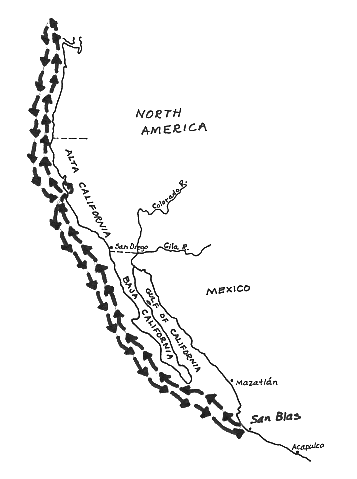| ||||
|
| ||||
|
BRUNO
HECETA and
JUAN DE LA BODEGA
and the Northern Coast
 Lived:
1700s
Lived:
1700s
Explored California in: 1775
Exploring for: Spain
Explored: by sea along the northern California coast
After more than 150 years of
paying no attention to Alta (Upper) California,
EARLY HISTORY
Bruno Heceta (sometimes spelled Hezeta)
was a Spanish captain. His lieutenant, Juan Francisco de la Bodéga,
was the son of a Spanish official in
BACKGROUND
In 1774 the viceroy of New Spain was Antonio María Bucareli y Ursúa. It was under his direction that Juan Bautista de Anza’s expedition to San Francisco in 1774-75 was organized. Viceroy Bucareli also organized explorations by sea along the California coast in 1775.
This sea journey was made by a fleet of three ships. The San Carlos under the command of Juan Manuel de Ayala was to go as far as San Francisco Bay, enter the bay, and explore it.
The Santiago, captained
by Bruno Heceta, and the Sonora, under the
command of Heceta’s lieutenant, Juan Francisco de
la Bodéga, were to go further
north along the coast. Once again,
HECETA’S and BODEGA’S JOURNEYS
The Santiago, the
Sonora, and the San Carlos sailed north together in March 1775
from San Blas on the coast of
The ships found a good anchorage
in a bay at 41° latitude on the northern California coast. They named the
bay Puerto de la Trinidad (Trinity Bay) because it was Trinity Sunday
when they arrived here. They landed on the tree-lined shore and Heceta
took possession of the land in the name of the king of
The next stop for Heceta and Bodega was not so friendly. Some of the crew went ashore and were killed by the Indians. The ships escaped from a ring of Indian canoes, and headed north.
On July 27, 1775, Heceta noted the existence of a mighty river emptying into the ocean. This was the first recorded mention of the Columbia River. Three days later, a storm arose. The Santiago and the Sonora got separated in the rain and mist. Though both ships continued northward, they did not see each other again until they had turned south and arrived back at Monterey.
Heceta sailed as far north as Nootka, on the west coast of Vancouver Island. He then turned southward and sailed the Santiago along the coast back to Monterey. As he passed the entrance to San Francisco Bay, he was curious and wanted to explore it.
When at Monterey, Heceta organized an expedition to travel to San Francisco Bay on land. He took four sailors on horseback, two priests on mules, plus nine soldiers and a pack train carrying a canoe. They went up the peninsula side of the bay. At the tip of the peninsula, Heceta found a cross with a message at its foot. This message had been left by Juan de Ayala, who had been the first to sail into the bay just a few weeks before Heceta visited.
With Heceta on this trip was Father Francisco Palóu, who had made the same trip the previous year with Capt. Rivera. On that trip Father Palóu had chosen a site for a mission near present-day Palo Alto. That mission was never built. Though Palóu went to the tip of the peninsula, where the city of San Francisco is now located, he did not consider this a good mission site. By 1776 he had changed his mind, and founded Mission San Francisco de Asís there.
Bodéga on the Sonora continued on north, surveying
the coast as far as Alaska. He came within sight of the mountains near what
is now Sitka, Alaska, and claimed it all for
When Bodéga turned south and once again reached the coast of Northern California, he paid particular attention to the area around Cape Mendocino. He named Puerto del Capitan de Bodéga (Bodega Bay) and Tomales Bay.
The three ships that had set
out from San Blas in March 1775 now met once again
in October in Monterey. They returned together to San Blas
in
WHAT THEY ACCOMPLISHED
The claim of
LATER YEARS
When he returned to
Almost 20 years later, in 1792,
Bodega was again in northern waters. He was the naval commandant at San Blas
in